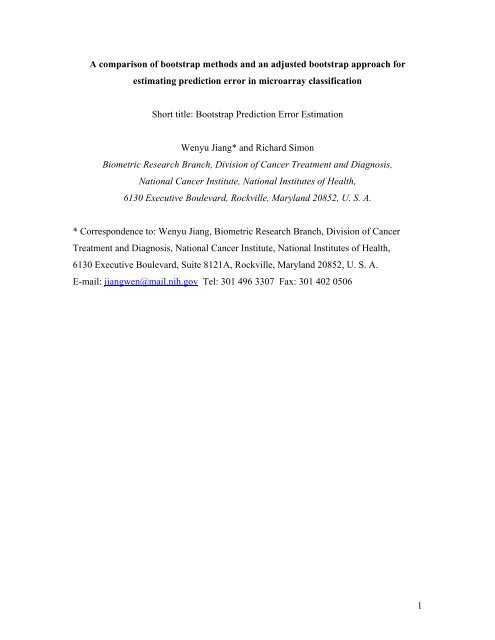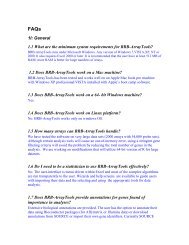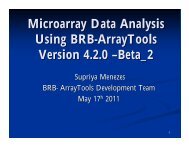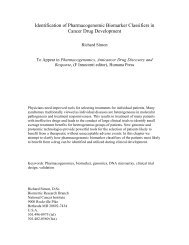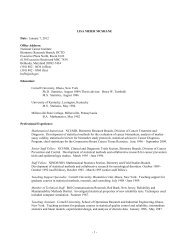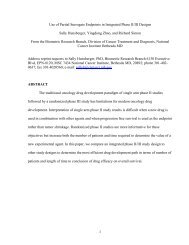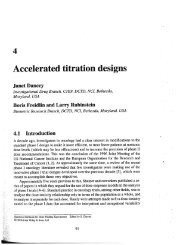A comparison of bootstrap methods and an adjusted bootstrap ...
A comparison of bootstrap methods and an adjusted bootstrap ...
A comparison of bootstrap methods and an adjusted bootstrap ...
You also want an ePaper? Increase the reach of your titles
YUMPU automatically turns print PDFs into web optimized ePapers that Google loves.
n> p situation, the .632+ <strong>bootstrap</strong> is very popular for having low variability <strong><strong>an</strong>d</strong> onlymoderate bias. However, the study in this paper <strong><strong>an</strong>d</strong> the work <strong>of</strong> Molinaro et al. [8]suggest that the .632+ <strong>bootstrap</strong> c<strong>an</strong> run into problems in the n< p situation. Wepropose <strong>an</strong> <strong>adjusted</strong> <strong>bootstrap</strong> method, its perform<strong>an</strong>ce is robust in various situations <strong><strong>an</strong>d</strong>it achieves a good compromise in the bias-vari<strong>an</strong>ce trade<strong>of</strong>f.2. A REVIEW OF METHODS FOR PREDICTION ERROR ESTIMATIONIn microarray class prediction problem, we observe x = ( t , y ) , i = 1,..., n, oni i inindependent subjects wheretiis ap -dimensional vector containing the gene expressionmeasurements <strong><strong>an</strong>d</strong>yiis the response for subject i . The observations x1,..., xnc<strong>an</strong> beviewed as realizations <strong>of</strong> <strong>an</strong> underlying r<strong><strong>an</strong>d</strong>om variable X = ( TY , ) . With dichotomousoutcome, the response variable Y takes 0 or 1 values distinguishing the two classes. Aprediction rule (model) r(· , xlearn ) is developed based on the information in the learningsetlearnx . The true prediction error ( en= E⎡I{ Y ≠r( T, x)}prediction model built on the observed data x ( x x )following the same r<strong><strong>an</strong>d</strong>om mech<strong>an</strong>ism as X .⎣⎤⎦ ) is the probability that the= ,..., 1 nmisclassifies a future itemWhen the prediction rule is built for the observed data, the prediction accuracy shouldideally be assessed on <strong>an</strong> independent large test set. But this <strong>of</strong>ten is impossible because<strong>of</strong> the relatively small sample sizes in microarray experiments. Methods for estimatingprediction errors rely on partitioning or resampling the observed data to construct thelearning <strong><strong>an</strong>d</strong> test sets. With a huge number <strong>of</strong> features, the prediction rules r( ⋅⋅ , ) containtwo key steps: the feature selection <strong><strong>an</strong>d</strong> the class prediction (discrimination) step. Featureselection is administered prior to the class prediction step for every learning set. Failureto include feature selection in resampling steps results in serious downward bias inestimating prediction error <strong><strong>an</strong>d</strong> overly optimistic assessment <strong>of</strong> the prediction rule [10, 11,7]. Methods for class prediction include various versions <strong>of</strong> discrimin<strong>an</strong>t <strong>an</strong>alysis, nearestneighbor classification, classification trees, etc. A comprehensive <strong>comparison</strong> <strong>of</strong> the classdiscrimination <strong>methods</strong> was conducted by Dudoit, Fridly<strong><strong>an</strong>d</strong> <strong><strong>an</strong>d</strong> Speed [12]. In this4
section, we concentrate on the <strong>bootstrap</strong> related <strong>methods</strong> for estimating prediction errors.For <strong>comparison</strong> purpose, we also include the resubstitution <strong><strong>an</strong>d</strong> the leave-one-out crossvalidation <strong>methods</strong>.The resubstitution estimate is known to underestimate the prediction error for using thesame data set to build <strong><strong>an</strong>d</strong> evaluate the prediction rule. Moreover, <strong>an</strong> overfitting problemarises in the n
Ordinary Bootstrap method [4] has the problem that the learning <strong><strong>an</strong>d</strong> test sets overlap. Inthis, a prediction rule is built on a <strong>bootstrap</strong> sample <strong><strong>an</strong>d</strong> tested on the original sample,averaging the misclassification rates across all <strong>bootstrap</strong> replications gives the ordinary<strong>bootstrap</strong> estimate. This method seriously underestimates the prediction error since asubset <strong>of</strong> data is used both in building <strong><strong>an</strong>d</strong> in assessing the prediction model.Bootstrap Cross-Validation The method is proposed by Fu, Carroll <strong><strong>an</strong>d</strong> W<strong>an</strong>g [9] toh<strong><strong>an</strong>d</strong>le small sample problems. The procedure generates B <strong>bootstrap</strong> samples <strong>of</strong> size nfrom the observed sample <strong><strong>an</strong>d</strong> then calculates a leave-one-out cross-validation estimateon each <strong>bootstrap</strong> sample. Averaging the B cross-validation estimates gives the <strong>bootstrap</strong>cross-validation estimate for the prediction error. The paper <strong>of</strong> Fu et al. [9] did notcarefully address the issue <strong>of</strong> feature selection. When the method is applied to highdimensional gene expression data, we emphasize that feature selection must be conductedin this method on every leave-one-out learning set derived from every <strong>bootstrap</strong> sample.Since <strong>an</strong> original observation c<strong>an</strong> appear more th<strong>an</strong> once in a <strong>bootstrap</strong> sample, a leaveone-outlearning set may overlap with the left out item when the cross-validationprocedure is applied on a <strong>bootstrap</strong> sample. Consequently, the <strong>bootstrap</strong> cross-validationmethod tends to underestimate the true prediction error.Leave-One-Out Bootstrap The leave-one-out <strong>bootstrap</strong> procedure (Efron [2]) generatesa total <strong>of</strong> B <strong>bootstrap</strong> samples <strong>of</strong> size n . Each observed specimen is predicted repeatedlyusing the <strong>bootstrap</strong> samples in which the particular observation does not appear. In thisway, the method avoids testing a prediction model on the specimens used for constructingthe model. The leave-one-out <strong>bootstrap</strong> estimate is given by*, b{ }e 1/ n 1/ | C | I y ≠r ( t , x ) where is the collection <strong>of</strong> <strong>bootstrap</strong>LOOBSnni= 1 i b∈Ci ii= ∑ ∑samples not containing observation i <strong><strong>an</strong>d</strong> | | is the number <strong>of</strong> such <strong>bootstrap</strong> samples.C i*,bFeature selection <strong><strong>an</strong>d</strong> class prediction should be performed on each <strong>bootstrap</strong> sample x ,b=1,..., B.C i6
The leave-one-out <strong>bootstrap</strong> is basically a smoothed version <strong>of</strong> the leave-one-out crossvalidation. To see this, the <strong>bootstrap</strong> samples inC ic<strong>an</strong> be viewed as r<strong><strong>an</strong>d</strong>om samples <strong>of</strong>sizex −n generated from the leave-i -out data set( i). Bootstrap samples are more differentbetween each other th<strong>an</strong> the original leave-one-out sets. Moreover, for each specimen i ,the leave-one-out <strong>bootstrap</strong> method averages on the errors from the multiple predictionsmade on the <strong>bootstrap</strong> samples inC i. As a result, the leave-one-out <strong>bootstrap</strong> estimate hasmuch smaller variability th<strong>an</strong> the leave-one-out cross validation estimate. On the otherh<strong><strong>an</strong>d</strong>, a <strong>bootstrap</strong> sample <strong>of</strong> size n contains roughly .632n distinct observations from theoriginal sample. It is <strong>of</strong>ten inadequate to represent the distribution <strong>of</strong> the original datawhen the sample size n is small. Hence the leave-one-out <strong>bootstrap</strong> estimate tends tooverestimate the true prediction error.Out-<strong>of</strong>-Bag Estimation The out-<strong>of</strong>-bag estimate [5] for the prediction error is a byproduct<strong>of</strong> bagging predictors (Bagging [6]). The out-<strong>of</strong>-bag estimate is themisclassification rate when predicting for each observation by the class that wins themajority votes from the multiple predictions, made on the <strong>bootstrap</strong> samples in which theparticular observation is out-<strong>of</strong>-bag (i.e., not included).The out-<strong>of</strong>-bag estimation makes <strong>an</strong> interesting <strong>comparison</strong> to the leave-one-out<strong>bootstrap</strong>. The out-<strong>of</strong>-bag estimation employs a majority vote on the multiple predictionsmade for observation i based on the <strong>bootstrap</strong> samples in, while the leave-one-out<strong>bootstrap</strong> takes <strong>an</strong> average on errors <strong>of</strong> these predictions. The out-<strong>of</strong>-bag estimation c<strong>an</strong>be viewed as a non-smooth vari<strong>an</strong>t <strong><strong>an</strong>d</strong> we envisage it to have larger variability th<strong>an</strong> theleave-one-out <strong>bootstrap</strong> when the sample size is small.C i.632+ Bootstrap The .632+ <strong>bootstrap</strong> is proposed by Efron <strong><strong>an</strong>d</strong> Tibshir<strong>an</strong>i [3] in order toreduce the upward bias <strong>of</strong> the leave-one-out <strong>bootstrap</strong>. The estimate has the form.632LOOBSRSBe + n = we n + (1 −w)e n where the weight wRSBis between 0 <strong><strong>an</strong>d</strong> 1 <strong><strong>an</strong>d</strong> e n is theresubstitution estimate. Taking w = 0.632 gives the .632 <strong>bootstrap</strong> originally proposedby Efron [2]. When the resubstitution error is zero, the .632 <strong>bootstrap</strong> estimate7
ecomes e , this results in systematic downward bias when there are no classdifferences (Breim<strong>an</strong> et al. [13], Efron <strong><strong>an</strong>d</strong> Tibshir<strong>an</strong>i [3]). The .632+ <strong>bootstrap</strong> aims tocircumvent this problem by increasing the weight w with respect to the growing level <strong>of</strong>overfitting. It <strong>of</strong>ten performs well in classification problems with n>p. For microarray0.632 LOOBSndata with n
Let cl ( ) be the ch<strong>an</strong>ces that <strong>an</strong> observation appears in a <strong>bootstrap</strong> sample <strong>of</strong> size ln . Asimple probabilistic argument indicates that cl ( ) ≈1−e −l . A <strong>bootstrap</strong> sample <strong>of</strong> sizeln contains approximately cl ( ) ⋅ndistinct observations from the original sample. Forexample, for l = 1,2,3 , the number <strong>of</strong> distinct observations is about 0.632n , 0.865n ,0.95n respectively. With l = 1, the repeated leave-one-out <strong>bootstrap</strong> closely resemblesthe leave-one-out <strong>bootstrap</strong> procedure. Asl increases, a <strong>bootstrap</strong> learning set for a leftoutitem contains more distinct observations. On one h<strong><strong>an</strong>d</strong>, the method acquiresadditional accuracy <strong><strong>an</strong>d</strong> brings a reduction on the upward bias. On the other h<strong><strong>an</strong>d</strong>, the<strong>bootstrap</strong> learning sets obtained from the same leave-one-out set become more similar instructure <strong><strong>an</strong>d</strong> this raises the variability <strong>of</strong> the estimation.The learning behavior <strong>of</strong> the repeated leave-one-out <strong>bootstrap</strong> c<strong>an</strong> be modeled as afunction <strong>of</strong> the number <strong>of</strong> distinct observations included in the <strong>bootstrap</strong> learning sets.The trend <strong>of</strong> a learning process as a function <strong>of</strong> sample size is <strong>of</strong>ten modeled in themachine learning literature by a flexible curve following <strong>an</strong> inverse power law. Letthe expected number <strong>of</strong> distinct observations to appear in a <strong>bootstrap</strong> sample <strong>of</strong> sizeln .Letem ( )be the expected error rate given the observed sample using the repeated leaveone-out<strong>bootstrap</strong> method with <strong>bootstrap</strong> learning sets <strong>of</strong> sizeln . Ideally,follow the inverse power lawwhere a , α <strong><strong>an</strong>d</strong> b are the parameters.−αem ( ) = am + bem ( )shouldm beThe Adjusted Bootstrap method estimates the prediction error as follows. PickJ <strong>bootstrap</strong> learning set sizes ln,j = 1,..., J . Compute the repeated leave-one-outjRLOOB<strong>bootstrap</strong> estimate e RLOOBn ( lj) with <strong>bootstrap</strong> learning sets <strong>of</strong> size lnj.Denote en ( lj)by e where m = c( l ) ⋅nis the expected number <strong>of</strong> distinct original observations in am jjj<strong>bootstrap</strong> learning set <strong>of</strong> size ln. Fit <strong>an</strong> empirical learning curve <strong>of</strong> thej9
form e = am −α+b with j=1, …, J. The estimates a , α <strong><strong>an</strong>d</strong> for the parameters aremjjobtained by minimizing the non-linear least squares functionJ∑j=1b { } 2mj−αje −am −b.The <strong>adjusted</strong> <strong>bootstrap</strong> estimate for the prediction error is given byABSe n = <strong>an</strong> −α+ b .It is the fitted value on the learning curve as if all original observations contributed to <strong>an</strong>individual <strong>bootstrap</strong> learning set.In practice, the choice <strong>of</strong> l c<strong>an</strong> r<strong>an</strong>ge from somewhere close to 1 to a value greater th<strong>an</strong> 5.Repeated leave-one-out <strong>bootstrap</strong> estimates typically have lower variability th<strong>an</strong> leaveone-outcross-validation. They have <strong>an</strong> upward bias that decreases <strong><strong>an</strong>d</strong> their variabilityincreases with the expected number <strong>of</strong> distinct original observations selected in <strong>bootstrap</strong>.Fitting <strong>an</strong> inverse power law curve to a series <strong>of</strong> repeated leave-one-out <strong>bootstrap</strong> valuesenables us to define a conservative estimate (not subject to downward bias) that providesa compromise between estimates with large variability <strong><strong>an</strong>d</strong> large upward bias. Inversepower law curve is a flexible way to model a learning process, <strong><strong>an</strong>d</strong> is quite typical indescribing machine learning, hum<strong>an</strong> <strong><strong>an</strong>d</strong> <strong>an</strong>imal learning behavior (Shrager et. al. [14]).Mukherjee et al. [15] studied sample size requirements in microarray classification usinga similar learning curve.4. COMPARISON OF METHODSIn this section, we compare the <strong>methods</strong> described in Sections 2 <strong><strong>an</strong>d</strong> 3 through simulationstudy <strong><strong>an</strong>d</strong> <strong>an</strong> application to a lymphoma dataset.4.1 Simulated DataSimilar simulated data sets are considered in Molinaro et al. [8]. For each simulateddataset, generate a sample <strong>of</strong> n patients, each with p genes (or features). Half <strong>of</strong> thepatients are in class 0 <strong><strong>an</strong>d</strong> half in class 1 divided according to disease status. Geneexpression levels are generated from a normal distribution with covari<strong>an</strong>ce10
matrix Σ= ( σ ij), i, j = 1,..., p, where the only nonzero entries are σ = 1 <strong><strong>an</strong>d</strong>σ = 0.2 with 0 < | i− j| ≤5. For class 0 patients, genes are generated with me<strong>an</strong> 0. Forijclass 1 patients, 1% <strong>of</strong> the genes are generated with me<strong>an</strong> µ1, 1% with me<strong>an</strong> µ 2<strong><strong>an</strong>d</strong> therest with me<strong>an</strong> 0.iiIn each simulation run, a prediction model is built on the sample <strong>of</strong> size n <strong><strong>an</strong>d</strong> tested on1000 independent data generated with the same structure. The resulting error rateestimates the true prediction error for the sample <strong><strong>an</strong>d</strong> is denoted by e n . For each method,we report the averaged estimate (Est.) <strong><strong>an</strong>d</strong> the st<strong><strong>an</strong>d</strong>ard deviation (STD) calculated acrossR=1000 simulation replications, as well as the averaged bias (Bias) <strong><strong>an</strong>d</strong> me<strong>an</strong> squarederror (MSE) with respect to the “true” prediction error e n . We have estimated thevariability (STD) <strong>of</strong> a method <strong>of</strong> estimating prediction error using simulation, but such avariability estimate would not be available for <strong>an</strong>alysis <strong>of</strong> a single dataset.For class discrimination, we consider in the simulation the diagonal linear discrimin<strong>an</strong>t<strong>an</strong>alysis (DLDA), the one nearest neighbor with Euclide<strong>an</strong> dist<strong>an</strong>ce (1NN) <strong><strong>an</strong>d</strong> theclassification <strong><strong>an</strong>d</strong> regression tree (CART). These algorithms are available through built-infunctions in the statistical package R [16]. Details <strong>of</strong> these R functions are described inMolinaro et al. [8]. For all <strong>methods</strong> reviewed in Section 2, we draw B = 100 <strong>bootstrap</strong>samples. Running 50 to 100 <strong>bootstrap</strong> replications is <strong>of</strong>ten considered more th<strong>an</strong> adequate(Efron <strong><strong>an</strong>d</strong> Tibshir<strong>an</strong>i [3, 4]). For the repeated leave-one-out <strong>bootstrap</strong> <strong><strong>an</strong>d</strong> the <strong>adjusted</strong><strong>bootstrap</strong>, we run B1= 50 <strong>bootstrap</strong> replications on every leave-one-out set <strong><strong>an</strong>d</strong> use themto predict for the left-out observation. This should be quite sufficient in <strong>comparison</strong> to theleave-one-out <strong>bootstrap</strong> method, in which B <strong>bootstrap</strong> replications provide about0.368B<strong>bootstrap</strong> samples not containing (<strong><strong>an</strong>d</strong> to predict for) a specific observation. The <strong>adjusted</strong><strong>bootstrap</strong> method is fitted onJ = 6 repeated leave-one-out <strong>bootstrap</strong> estimateswith l =0.75, 1,1.5,2, 3, 10, so that the number <strong>of</strong> original observations contributing to theresampled learning set spreads out across a reasonable r<strong>an</strong>ge for small sample problems.11
In Table 1, we report the simulation results for two cases with n=20. In Case 1, weconsider the no signal situation, where there are no differentially expressed genesbetween the two classes ( µ1= µ2= 0 in the simulation model). In Case 2, we consider asituation with moderate to strong signals ( µ1= 0.5, µ2= 1.5 in the simulation model).We reported the <strong>methods</strong> in groups with subst<strong>an</strong>tial downward bias, large variability <strong><strong>an</strong>d</strong>large upward bias, <strong><strong>an</strong>d</strong> in all Tables, cells with these unfavorable features are highlightedin boldface. Figure 1 clearly displays the comparative perform<strong>an</strong>ce <strong>of</strong> the <strong>methods</strong> for thetwo contrasting cases with n=20 using DLDA.We first look at the outcome when the DLDA <strong><strong>an</strong>d</strong>/or 1NN classifiers are used in Table 1<strong><strong>an</strong>d</strong> Figure 1. Results using these two classifiers are very similar. The resubstitutionestimates are close to zero in the study. The ordinary <strong>bootstrap</strong> underestimates theprediction errors <strong><strong>an</strong>d</strong> the problem is more serious when there are weak or no signalsdistinguishing the classes (Case 1). The behavior <strong>of</strong> the <strong>bootstrap</strong> cross-validation methodis very similar to the ordinary <strong>bootstrap</strong> across all situations. With moderate to strongsignals, the .632 <strong>bootstrap</strong> performs well in terms <strong>of</strong> bias, st<strong><strong>an</strong>d</strong>ard deviation <strong><strong>an</strong>d</strong> me<strong>an</strong>squared error. But the .632 <strong>bootstrap</strong> suffers from a systematic downward bias whenthere is no signal (Case 1). The leave-one-out cross-validation estimate is almostunbiased, but its st<strong><strong>an</strong>d</strong>ard deviation becomes very large as the signal diminishes. The<strong>bootstrap</strong> related <strong>methods</strong> reviewed in Section 2 generally have small variability. Theonly exception is the out-<strong>of</strong>-bag estimate. It <strong>of</strong>ten gives st<strong><strong>an</strong>d</strong>ard deviations as large asthe leave-one-out cross-validation <strong><strong>an</strong>d</strong> is much more unstable th<strong>an</strong> the leave-one-out<strong>bootstrap</strong>. With strong signals <strong><strong>an</strong>d</strong> small sample sizes, the leave-one-out <strong>bootstrap</strong> hasvery large upward bias; the .632+ <strong>bootstrap</strong> reduces the bias <strong>of</strong> the leave-one-out<strong>bootstrap</strong> to some extent but still seriously overestimates the truth. In Case 2 with DLDA,for example, the bias-to-“true”-error ratios are more th<strong>an</strong> 90% <strong><strong>an</strong>d</strong> 70% for leave-one-out<strong>bootstrap</strong> <strong><strong>an</strong>d</strong> the .632+ <strong>bootstrap</strong> with DLDA classifier. In situations with no signals,however, the leave-one-out <strong>bootstrap</strong> <strong><strong>an</strong>d</strong> the .632+ <strong>bootstrap</strong> both work very well. The<strong>adjusted</strong> <strong>bootstrap</strong> estimate evidently reduces the bias <strong>of</strong> the leave-one-out <strong>bootstrap</strong>estimate <strong><strong>an</strong>d</strong> variability <strong>of</strong> the leave-one-out cross-validation.Insert Table 1 <strong><strong>an</strong>d</strong> Figure 1 about here.12
We also present in Table 1 the repeated leave-one-out <strong>bootstrap</strong> estimates with l = 1, 2<strong><strong>an</strong>d</strong> 10. With small l, the repeated leave-one-out <strong>bootstrap</strong> estimate gives small st<strong><strong>an</strong>d</strong>arddeviation but c<strong>an</strong> have a large upward bias. Increasing l in the method tends to reduce theupward bias but raise the st<strong><strong>an</strong>d</strong>ard deviation. This along with Figure 2 illustrates therationale for the <strong>adjusted</strong> <strong>bootstrap</strong> approach. In Figure 2, we plot the repeated leave-oneout<strong>bootstrap</strong> estimates (using DLDA classifier) with l=0.75, 1,1.5,2, 3, 10 against thecorresponding values <strong>of</strong> cl ( ) for one <strong>of</strong> the simulated dataset with µ1= 0.5, µ2= 1.5 <strong><strong>an</strong>d</strong>n=20. The qu<strong>an</strong>tity cl ( ) shows roughly the proportion <strong>of</strong> the distinct observations fromthe original sample to appear in a <strong>bootstrap</strong> learning set <strong>of</strong> size ln . Also presented inFigure 2 is <strong>an</strong> inverse power law learning curve fitted through the <strong>adjusted</strong> <strong>bootstrap</strong>approach. The “true” error rate <strong><strong>an</strong>d</strong> the leave-one-out cross-validation estimate areindicated by “t” <strong><strong>an</strong>d</strong> “c” on the plot. When implementing the <strong>adjusted</strong> <strong>bootstrap</strong> method,we use the R function “nlm”, a non-linear minimization algorithm, to estimate for theparameters.Insert Figure 2 about here.In Table 1, we notice that using CART in the <strong>methods</strong> gives larger prediction error ratesth<strong>an</strong> using the other two classifiers. The CART classifier const<strong>an</strong>tly overfits the data inthe presence <strong>of</strong> large amount <strong>of</strong> noise. Not surprisingly, the resampling <strong>methods</strong> usingCART become less sensitive to the varying sizes <strong>of</strong> the learning sets. Thus, the leaveone-out<strong>bootstrap</strong> has a smaller upward bias with CART th<strong>an</strong> with the other twoclassifiers. The .632+ <strong>bootstrap</strong> performs well with CART when n=20. The repeatedleave-one-out <strong>bootstrap</strong> estimates using CART ch<strong>an</strong>ge only mildly as the size <strong>of</strong> the<strong>bootstrap</strong> learning set ln increases <strong><strong>an</strong>d</strong> this reduces the benefit <strong>of</strong> the <strong>adjusted</strong> <strong>bootstrap</strong>method. But it remains slightly conservative <strong><strong>an</strong>d</strong> still reduces the large variability <strong>of</strong> theleave-one-out cross-validation <strong><strong>an</strong>d</strong> performs reasonably well under varying signal levels.To see how the relative perform<strong>an</strong>ce <strong>of</strong> the <strong>methods</strong> ch<strong>an</strong>ges with sample sizes alongwith varying signal levels, in Tables 2 <strong><strong>an</strong>d</strong> 3, we report the results for n=40 <strong><strong>an</strong>d</strong> n=100.In each Table, Case 1 is the no signal situation, <strong><strong>an</strong>d</strong> Case 2 is a situation with strong13
signals ( µ = 1.5 i.e. µ1= µ2in the simulation model). With these larger sample sizes(even with n=100), we find that when there are no real differences between the twoclasses, the out-<strong>of</strong>-bag estimation (OOB) <strong><strong>an</strong>d</strong> the leave-one-out cross-validation (LOOCV)still give larger variability compared to other <strong>methods</strong>; the resubstitution, the ordinary<strong>bootstrap</strong>, the <strong>bootstrap</strong> cross-validation <strong><strong>an</strong>d</strong> the .632 <strong>bootstrap</strong> still have subst<strong>an</strong>tialdownward bias (Case 1, Tables 2 <strong><strong>an</strong>d</strong> 3). When there are strong differences between theclasses, the LOOCV <strong><strong>an</strong>d</strong> OOB give smaller variability, <strong><strong>an</strong>d</strong> the resubstitution, theordinary <strong>bootstrap</strong>, the <strong>bootstrap</strong> cross-validation <strong><strong>an</strong>d</strong> the .632 <strong>bootstrap</strong> give smallerdownward bias (Case 2, Tables 2 <strong><strong>an</strong>d</strong> 3) as sample size n increases in <strong>comparison</strong> to Case2, Table 1. The .632+ <strong>bootstrap</strong> <strong><strong>an</strong>d</strong> the OOB perform better as sample size increases, butthey sometimes suffer from downward bias when n=40 <strong><strong>an</strong>d</strong> 100 (Case 2, Tables 2 <strong><strong>an</strong>d</strong> 3)<strong><strong>an</strong>d</strong> this is illustrated in Figure 3 using the results for n=40 with CART classifier.The <strong>adjusted</strong> <strong>bootstrap</strong> is robust in the sense that it remains conservative (has nodownward bias) under all circumst<strong>an</strong>ces considered in the simulation with varying signallevels, classifiers <strong><strong>an</strong>d</strong> sample sizes. It does not suffer from extremely large upward bias orvariability in <strong>comparison</strong> to other <strong>methods</strong> for small to moderate sized samples (Tables 1<strong><strong>an</strong>d</strong> 2), <strong><strong>an</strong>d</strong> it performs no worse th<strong>an</strong> the competitors such as the .632+ <strong>bootstrap</strong>, theOOB <strong><strong>an</strong>d</strong> the LOOCV for larger sample sizes (Table 3).Insert Tables 2-3 <strong><strong>an</strong>d</strong> Figure 3 about here.Additional simulations are conducted for varying signals <strong><strong>an</strong>d</strong> n/p ratios (Tables A1, A2 insupplement). We found the comparative conclusion does not depend on the n/p ratios(with n
eported in the supplementary material for this paper available athttp://linus.nci.nih.gov/~brb/TechReport.htm.4.2 Lymphoma DataRosenwald et al. [17] conducted a microarray study among patients with large-B-celllymphoma <strong><strong>an</strong>d</strong> identified the germinal-center B-cell-like subgroup which had the highestfive-year survival rate after chemotherapy. The study measured 7399 genes on 240patients. In the following <strong>an</strong>alysis, we define the classes <strong>of</strong> outcome by the lymphomasubgroups, the germinal-center B-cell-like as class 1, the activated B-cell-like <strong><strong>an</strong>d</strong> type 3as class 0. This expression data provides only moderate signals to distinguish the classes(Wright et al. [18]). To assess the perform<strong>an</strong>ce <strong>of</strong> the <strong>methods</strong> described in Sections 2<strong><strong>an</strong>d</strong> 3, we repeatedly draw a sample <strong>of</strong> size n from the 240 patients, find the estimates forprediction error <strong><strong>an</strong>d</strong> use the remaining patients as <strong>an</strong> independent test set to calculate the“true” prediction error. This procedure is repeated R=1000 times. The number <strong>of</strong><strong>bootstrap</strong> replications is B=50 for the <strong>methods</strong> reviewed in Section 2 <strong><strong>an</strong>d</strong>repeated leave-one-out <strong>bootstrap</strong>.B1= 20for theWe present the results for n=14 <strong><strong>an</strong>d</strong> n=20 in Table 4 <strong><strong>an</strong>d</strong> only DLDA classifier is appliedin this study. Feature selection is performed prior to each application <strong>of</strong> DLDA bychoosing the 10 genes having the largest absolute-value t -statistics. With this moderatesignal example, the <strong>methods</strong> behave in conformity with the trend we observe from theprevious simulation study. The ordinary <strong>bootstrap</strong> <strong><strong>an</strong>d</strong> the <strong>bootstrap</strong> cross-validation areless competitive because they underestimate the true prediction error; the out-<strong>of</strong>-bagestimation is a less stable vari<strong>an</strong>t <strong>of</strong> the leave-one-out <strong>bootstrap</strong> while the .632 <strong>bootstrap</strong>performs well for both sample sizes. The leave-one-out cross-validation has the largestvariability. The leave-one-out <strong>bootstrap</strong> <strong><strong>an</strong>d</strong> the .632+ <strong>bootstrap</strong> overestimate the truth byabout 64% <strong><strong>an</strong>d</strong> 51% when n=14 <strong><strong>an</strong>d</strong> by 55% <strong><strong>an</strong>d</strong> 33% when n=20. With the <strong>adjusted</strong><strong>bootstrap</strong>, the ratios <strong>of</strong> overestimation drop to 20% <strong><strong>an</strong>d</strong> 14% for n=14 <strong><strong>an</strong>d</strong> n=20.5. DISCUSSION15
As CART is not a satisfactory classifier for high dimensional microarray data (Dudoit etal. [12]), we only included it in the simulation to evaluate how the classifiers interact withthe procedures for prediction error estimation. In the discussion, we mainly focus on<strong>methods</strong> using the two simpler <strong><strong>an</strong>d</strong> better-behaved classifiers, DLDA <strong><strong>an</strong>d</strong> 1NN.There is a bias-vari<strong>an</strong>ce trade-<strong>of</strong>f in the behavior <strong>of</strong> prediction error estimates <strong><strong>an</strong>d</strong> nomethod is universally better th<strong>an</strong> others with both bias <strong><strong>an</strong>d</strong> variability considerations.For example, the leave-one-out cross-validation <strong><strong>an</strong>d</strong> the leave-one-out <strong>bootstrap</strong>procedures includen −1<strong><strong>an</strong>d</strong> roughly .632 n distinct observations respectively in eachlearning set. As a consequence, the leave-one-out cross-validation is almost unbiased butc<strong>an</strong> have large variability; the leave-one-out <strong>bootstrap</strong> c<strong>an</strong> seriously overestimate the trueprediction error but has small variability. The leave-one-out cross-validation providessatisfactory estimates in strong signal situations <strong><strong>an</strong>d</strong> the leave-one-out <strong>bootstrap</strong> in the nosignal situations, but no method is the overall champion under all circumst<strong>an</strong>ces.Overlaps between the resampled learning <strong><strong>an</strong>d</strong> test sets cause serious underestimation <strong>of</strong>the prediction error. Such overlaps occur, for inst<strong>an</strong>ce, in the ordinary <strong>bootstrap</strong>procedure <strong><strong>an</strong>d</strong> the <strong>bootstrap</strong> cross-validation. Both estimates suffer from downward bias,which becomes quite subst<strong>an</strong>tial as the signal to discriminate the classes weakens. Thesimulation study on the <strong>bootstrap</strong> cross-validation method by Fu et al. [9] was limited tosituations with very strong signals <strong><strong>an</strong>d</strong> it overlooked the necessity <strong>of</strong> feature selection inthe resampling for high dimensional data. We examine the <strong>bootstrap</strong> cross-validationmethod in more extensive situations with proper feature selection. Overall, the <strong>bootstrap</strong>cross-validation estimate performs not much better th<strong>an</strong> the ordinary <strong>bootstrap</strong> estimate.All the <strong>methods</strong> reviewed in Section 2 encounter difficulties when estimating predictionerrors for high dimensional data with small samples. The leave-one-out cross-validation<strong><strong>an</strong>d</strong> the out-<strong>of</strong>-bag estimation suffer from large variability when the signal becomes weak.The leave-one-out <strong>bootstrap</strong> results in subst<strong>an</strong>tial upward bias as the signal level r<strong>an</strong>gesfrom moderate to strong. Efron <strong><strong>an</strong>d</strong> Tibshir<strong>an</strong>i [3] showed through simulation thatthe .632+ <strong>bootstrap</strong> works well for sample sizes as small as n=14 <strong><strong>an</strong>d</strong> 20 in the traditional16
n>p situation. However, the .632+ <strong>bootstrap</strong> is not as satisfactory in the n
ootstrap method <strong><strong>an</strong>d</strong> demonstrated that it is more robust th<strong>an</strong> other <strong>methods</strong> acrossvarying signal levels <strong><strong>an</strong>d</strong> classifiers in this context. For small to moderate sized samples,we suggest using the <strong>adjusted</strong> <strong>bootstrap</strong> method since 1) it remains conservative, henceavoids overly optimistic assessment <strong>of</strong> a prediction model; 2) it does not suffer fromextremely large bias or variability in <strong>comparison</strong> to other <strong>methods</strong>. These features <strong>of</strong> the<strong>adjusted</strong> <strong>bootstrap</strong> method are particularly appealing for small samples when otherprediction error estimation <strong>methods</strong> encounter difficulties.REFERENCES1. Stone M. Cross-validatory choice <strong><strong>an</strong>d</strong> assessment <strong>of</strong> statistical predictions. Journal <strong>of</strong>the Royal Statistical Society, Serial B 1974; 36: 111-147.2. Efron B. Estimating the error rate <strong>of</strong> a prediction rule: improvement on crossvalidation.Journal <strong>of</strong> the Americ<strong>an</strong> Statistical Association 1983; 78: 316-331.3. Efron B, Tibshir<strong>an</strong>i R. Improvement on cross-validation: the .632+ <strong>bootstrap</strong> method.Journal <strong>of</strong> the Americ<strong>an</strong> Statistical Association 1997; 92: 548-560.4. Efron B, Tibshir<strong>an</strong>i R. An Introduction to the Bootstrap. Chapm<strong>an</strong> <strong><strong>an</strong>d</strong> Hall, 1998.5. Breim<strong>an</strong> L. Out-<strong>of</strong> –bag estimation. Technical Report, Department <strong>of</strong> Statistics,University <strong>of</strong> California, Berkeley, 1996.6. Breim<strong>an</strong> L. Bagging predictors. Machine Learning 1996; 24:123-140.7. Dudoit S, Fridly<strong><strong>an</strong>d</strong> J. Classification in microarray experiments. Statistical Analysis <strong>of</strong>Gene Expression Microarray Data. Chapm<strong>an</strong> <strong><strong>an</strong>d</strong> Hall, 2003; pp 93-158.8. Molinaro AM, Simon R, Pfeiffer RM. Prediction error estimation: a <strong>comparison</strong> <strong>of</strong>resampling <strong>methods</strong>. Bioinformatics 2005; 21: 3301-3307.9. Fu W, Carroll RJ, W<strong>an</strong>g S. Estimating misclassification error with small samples via<strong>bootstrap</strong> cross-validation. Bioinformatics 2005; 21: 1979-1986.10. Simon R, Radmacher MD, Dobbin K, McSh<strong>an</strong>e LM. Pitfalls in the use <strong>of</strong> DNAmicroarray data for diagnostic <strong><strong>an</strong>d</strong> prognostic classification. Journal <strong>of</strong> the NationalC<strong>an</strong>cer Institute 2003; 95: 14-18.11. Ambroise C, McLachl<strong>an</strong> GJ. Selection bias in gene extraction on the basis <strong>of</strong>microarray gene-expression data. Proceedings <strong>of</strong> National Academy <strong>of</strong> Science 2002; 99:6562-6566.18
12. Dudoit S, Fridly<strong><strong>an</strong>d</strong> J, Speed T. Comparison <strong>of</strong> discrimination <strong>methods</strong> for theclassification <strong>of</strong> tumors using gene expression data. Journal <strong>of</strong> the Americ<strong>an</strong> StatisticalAssociation 2002; 97: 77-87.13. Breim<strong>an</strong> L, Friedm<strong>an</strong> J, Olshen R, Stone C. Classification <strong><strong>an</strong>d</strong> Regression Trees.Wadsworth, 1984.14. Shrager J, Hogg T, Huberm<strong>an</strong> BA. A graph-dynamic model <strong>of</strong> the power law <strong>of</strong>practice <strong><strong>an</strong>d</strong> the problem-solving f<strong>an</strong> effect. Science 1988; 242: 414-416.15. Mukherjee S, Tamayo P, Rogers S, Rifkin R, Engle A, Campbell C, Golub TR,Mesirov JP. Estimating dataset size requirements for classifying DNA microarray data.Journal <strong>of</strong> Computational Biology 2003; 10: 119-142.16. Ihaka R, Gentlem<strong>an</strong> R. R: a l<strong>an</strong>guage for data <strong>an</strong>alysis <strong><strong>an</strong>d</strong> graphics. Journal <strong>of</strong>Computational <strong><strong>an</strong>d</strong> Graphical Statistics 1996; 5: 299-314.17. Rosenwald A, Wright G, Ch<strong>an</strong> WC, Connors JM, Campo E, Fisher RI, Gascoyne RD,Muller-Hermelink HK, Smel<strong><strong>an</strong>d</strong> EB, Staudt LM. The use <strong>of</strong> molecular pr<strong>of</strong>iling topredict survival after chemotherapy for diffuse large B-cell lymphoma. New Engl<strong><strong>an</strong>d</strong>Journal <strong>of</strong> Medicine 2002; 346: 1937-1947.18. Wright G, T<strong>an</strong> B, Rosenwald A, Hurt EH, Wiestner A, Staudt LM. A geneexpression-based method to diagnose clinically distinct subgroups <strong>of</strong> diffuse large B celllymphoma. Proceedings <strong>of</strong> National Academy <strong>of</strong> Science USA 2003; 100: 9991-9996.19. Ghadimi BM, Grade M, Difilipp<strong>an</strong>tonio MJ, Varma S, Simon R, Montagna C, FuzesiL, L<strong>an</strong>ger C, Becker H, Liersch T, Ried T. Effectiveness <strong>of</strong> gene expression pr<strong>of</strong>iling forresponse prediction <strong>of</strong> rectal adenocarcinomas to preoperative chemoradiotherapy.Journal <strong>of</strong> Clinical Oncology 2005; 23:1826-1838.20. Cleator S, Tsimelzon A, Ashworth A, Dowsett M, Dexter T, Powles T, Hilsenbeck S,Wong H, Osborne CK, O’Connell P, Ch<strong>an</strong>g JC. Gene expression patterns for doxorubicin(Adriamycin) <strong><strong>an</strong>d</strong> cyclophosphamide (Cytox<strong>an</strong>) (AC) response <strong><strong>an</strong>d</strong> resist<strong>an</strong>ce. BreastC<strong>an</strong>cer Research <strong><strong>an</strong>d</strong> Treatment 2006; 95:229-233.21. Dupuy A, Simon R. Critical review <strong>of</strong> published microarray studies for c<strong>an</strong>ceroutcome <strong><strong>an</strong>d</strong> guidelines on statistical <strong>an</strong>alysis <strong><strong>an</strong>d</strong> reporting. Journal <strong>of</strong> the NationalC<strong>an</strong>cer Institute 2007; 99:147-157.19
Table 1. Simulation study with sample <strong>of</strong> size 20 <strong><strong>an</strong>d</strong> 800 genes. Two simulation setups are considered. Case 1: Nogenes are differentially expressed between the two classes. Case 2: Gene expression levels <strong>of</strong> class 0 patients follownormal distribution with me<strong>an</strong> 0; for class 1 patients, the 2% differentially expressed genes follow normal mixtures,half with me<strong>an</strong> µ = 0.5 <strong><strong>an</strong>d</strong> half with me<strong>an</strong> µ1 2= 1.5 . The “true” prediction error e is the misclassification ratenwhen a prediction rule built on the sample is tested on 1000 independent data with the same structure.Classifier Prediction Error Estimation Case 1: No differential genesCase 2: 2% differential genesMethod Est. STD Bias MSE Est. STD Bias MSEDLDA “True” Error ( e n )0.500 0.016 0.184 0.067Resubstitution 0.009 0.020 -0.491 0.242 0.006 0.017 -0.177 0.036Ordinary Bootstrap 0.196 0.022 -0.304 0.093 0.130 0.036 -0.054 0.006Bootstrap Cross Validation 0.205 0.024 -0.295 0.088 0.139 0.037 -0.045 0.006.632 Bootstrap 0.344 0.039 -0.157 0.026 0.229 0.064 0.045 0.007LOOCV 0.527 0.206 0.026 0.043 0.206 0.152 0.022 0.019Out-Of-Bag Estimation 0.590 0.156 0.090 0.033 0.243 0.153 0.059 0.022Leave-One-Out Bootstrap 0.538 0.059 0.038 0.005 0.359 0.098 0.175 0.038.632+ Bootstrap 0.516 0.054 0.015 0.003 0.318 0.111 0.134 0.027RLOOB:l=1 0.539 0.058 0.039 0.005 0.358 0.098 0.175 0.038RLOOB:l=2 0.537 0.098 0.036 0.011 0.278 0.121 0.095 0.020RLOOB:l=10 0.532 0.160 0.032 0.027 0.217 0.136 0.034 0.015Adjusted Bootstrap 0.534 0.128 0.033 0.018 0.237 0.133 0.053 0.0161NN “True” Error ( e n )0.501 0.016 0.211 0.071Resubstitution 0 0 -0.501 0.251 0 0 -0.211 0.050Ordinary Bootstrap 0.194 0.021 -0.306 0.094 0.127 0.038 -0.085 0.010Bootstrap Cross Validation 0.205 0.022 -0.296 0.088 0.136 0.040 -0.075 0.009.632 Bootstrap 0.342 0.036 -0.159 0.027 0.223 0.067 0.012 0.004LOOCV 0.529 0.184 0.029 0.035 0.241 0.166 0.030 0.020Out-<strong>of</strong>-Bag Estimation 0.600 0.161 0.100 0.036 0.243 0.161 0.031 0.018Leave-One-Out Bootstrap 0.541 0.058 0.040 0.005 0.354 0.106 0.142 0.027.632+ Bootstrap 0.518 0.051 0.018 0.003 0.312 0.118 0.100 0.018RLOOB:l=1 0.541 0.055 0.041 0.005 0.354 0.105 0.143 0.027RLOOB:l=2 0.536 0.090 0.036 0.010 0.289 0.127 0.077 0.015RLOOB:l=10 0.532 0.140 0.032 0.021 0.247 0.144 0.036 0.014Adjusted Bootstrap 0.533 0.114 0.032 0.014 0.258 0.139 0.046 0.014CART “True” Error ( e n )0.500 0.016 0.290 0.089Resubstitution 0 0 -0.500 0.250 0 0 -0.290 0.092Ordinary Bootstrap 0.188 0.020 -0.312 0.098 0.129 0.041 -0.162 0.033Bootstrap Cross Validation 0.197 0.022 -0.303 0.092 0.135 0.042 -0.156 0.031.632 Bootstrap 0.331 0.034 -0.169 0.030 0.227 0.073 -0.064 0.013LOOCV 0.528 0.225 0.029 0.516 0.326 0.194 0.035 0.038Out-<strong>of</strong>-Bag Estimation 0.574 0.180 0.074 0.038 0.253 0.150 -0.038 0.022Leave-One-Out Bootstrap 0.524 0.054 0.024 0.004 0.359 0.115 0.068 0.018.632+ Bootstrap 0.505 0.056 0.005 0.003 0.320 0.126 0.030 0.016RLOOB:l=1 0.523 0.053 0.023 0.004 0.358 0.114 0.067 0.018RLOOB:l=2 0.521 0.099 0.021 0.010 0.350 0.136 0.060 0.023RLOOB:l=10 0.520 0.173 0.020 0.030 0.331 0.170 0.041 0.032Adjusted Bootstrap 0.520 0.135 0.020 0.019 0.343 0.155 0.053 0.028DLDA: diagonal linear discrimin<strong>an</strong>t <strong>an</strong>alysis; 1NN: one nearest neighbor; CART: classification <strong><strong>an</strong>d</strong> regression tree.RLOOB: repeated leave-one-out <strong>bootstrap</strong>20
Table 2. Simulation study with sample <strong>of</strong> size 40 <strong><strong>an</strong>d</strong> 800 genes. Two simulation setups are considered. Case 1: Nogenes are differentially expressed between the two classes. Case 2: Gene expression levels <strong>of</strong> class 0 patients follownormal distribution with me<strong>an</strong> 0; for class 1 patients, the 2% differentially expressed genes follow normal distributionwith me<strong>an</strong> µ = 1.5 . The “true” prediction error e nis the misclassification rate when a prediction rule built on thesample is tested on 1000 independent data with the same structure.Classifier Prediction Error Estimation Case 1: No differential genesCase 2: 2% differential genesMethod Est. STD Bias MSE Est. STD Bias MSEDLDA “True” Error ( e n )0.501 0.016 0.052 0.010Resubstitution 0.066 0.035 -0.435 0.191 0.021 0.022 -0.031 0.0016Ordinary Bootstrap 0.224 0.020 -0.277 0.077 0.040 0.020 -0.012 0.0007Bootstrap Cross Validation 0.226 0.021 -0.274 0.076 0.042 0.021 -0.010 0.0007.632 Bootstrap 0.351 0.034 -0.150 0.024 0.062 0.033 0.010 0.0013LOOCV 0.513 0.160 0.012 0.026 0.053 0.038 0.001 0.0015Out-Of-Bag Estimation 0.539 0.113 0.038 0.014 0.049 0.036 -0.003 0.0014Leave-One-Out Bootstrap 0.517 0.043 0.016 0.002 0.087 0.043 0.035 0.0032.632+ Bootstrap 0.502 0.043 0.001 0.002 0.065 0.035 0.013 0.0015Adjusted Bootstrap 0.514 0.085 0.013 0.008 0.056 0.033 0.004 0.00121NN “True” Error ( e n )0.501 0.016 0.079 0.020Resubstitution 0 0 -0.501 0.251 0 0 -0.079 0.0066Ordinary Bootstrap 0.188 0.013 -0.312 0.098 0.040 0.018 -0.038 0.0019Bootstrap Cross Validation 0.193 0.014 -0.308 0.095 0.042 0.019 -0.037 0.0018.632 Bootstrap 0.328 0.022 -0.173 0.031 0.070 0.032 -0.008 0.0009LOOCV 0.520 0.132 0.019 0.018 0.079 0.055 0.000 0.0023Out-<strong>of</strong>-Bag Estimation 0.550 0.110 0.049 0.015 0.058 0.042 -0.021 0.0019Leave-One-Out Bootstrap 0.519 0.036 0.018 0.002 0.111 0.050 0.033 0.0031.632+ Bootstrap 0.505 0.035 0.005 0.001 0.078 0.038 -0.000 0.0012Adjusted Bootstrap 0.517 0.064 0.016 0.005 0.085 0.047 0.006 0.0017CART “True” Error ( e n )0.500 0.016 0.221 0.042Resubstitution 0.028 0.019 -0.471 0.223 0.020 0.017 -0.201 0.042Ordinary Bootstrap 0.188 0.011 -0.312 0.097 0.085 0.019 -0.136 0.020Bootstrap Cross Validation 0.191 0.013 -0.309 0.096 0.085 0.019 -0.136 0.020.632 Bootstrap 0.335 0.019 -0.165 0.028 0.153 0.035 -0.069 0.007LOOCV 0.515 0.175 0.015 0.031 0.212 0.112 -0.010 0.012Out-<strong>of</strong>-Bag Estimation 0.543 0.113 0.043 0.015 0.123 0.049 -0.099 0.013Leave-One-Out Bootstrap 0.513 0.029 0.013 0.001 0.230 0.052 0.009 0.004.632+ Bootstrap 0.503 0.029 0.003 0.001 0.180 0.047 -0.041 0.005Adjusted Bootstrap 0.513 0.069 0.014 0.005 0.225 0.078 0.004 0.006DLDA: diagonal linear discrimin<strong>an</strong>t <strong>an</strong>alysis; 1NN: one nearest neighbor; CART: classification <strong><strong>an</strong>d</strong> regression tree.21
Table 3. Simulation study with sample <strong>of</strong> size 100 <strong><strong>an</strong>d</strong> 800 genes. Two simulation setups are considered. Case 1: Nogenes are differentially expressed between the two classes. Case 2: Gene expression levels <strong>of</strong> class 0 patients follownormal distribution with me<strong>an</strong> 0; for class 1 patients, the 2% differentially expressed genes follow normal distributionwith me<strong>an</strong> µ = 1.5 . The “true” prediction error e n is the misclassification rate when a prediction rule built on thesample is tested on 1000 independent data with the same structure.Classifier Prediction Error Estimation Case 1: No differential genesCase 2: 2% differential genesMethod Est. STD Bias MSE Est. STD Bias MSEDLDA “True” Error ( e n )0.500 0.016 0.049 0.008Resubstitution 0.183 0.031 -0.317 0.102 0.031 0.018 -0.018 0.0007Ordinary Bootstrap 0.291 0.015 -0.209 0.044 0.037 0.014 -0.012 0.0004Bootstrap Cross Validation 0.292 0.016 -0.208 0.044 0.037 0.014 -0.012 0.0004.632 Bootstrap 0.386 0.023 -0.114 0.014 0.043 0.016 -0.006 0.0003LOOCV 0.498 0.110 -0.002 0.012 0.047 0.023 -0.001 0.0006Out-Of-Bag Estimation 0.510 0.069 0.010 0.005 0.040 0.019 -0.009 0.0005Leave-One-Out Bootstrap 0.504 0.026 0.004 0.001 0.050 0.017 0.001 0.0003.632+ Bootstrap 0.496 0.028 -0.005 0.001 0.043 0.016 -0.006 0.0003Adjusted Bootstrap 0.503 0.048 0.003 0.003 0.049 0.018 0.000 0.00041NN “True” Error ( e n )0.500 0.015 0.076 0.015Resubstitution 0 0 -0.500 0.251 0 0 -0.076 0.0059Ordinary Bootstrap 0.185 0.007 -0.315 0.100 0.029 0.009 -0.047 0.0024Bootstrap Cross Validation 0.187 0.008 -0.314 0.099 0.029 0.009 -0.047 0.0024.632 Bootstrap 0.320 0.012 -0.181 0.033 0.049 0.015 -0.026 0.0009LOOCV 0.504 0.081 0.003 0.007 0.076 0.034 -0.000 0.0009Out-<strong>of</strong>-Bag Estimation 0.519 0.068 0.019 0.005 0.050 0.024 -0.026 0.0012Leave-One-Out Bootstrap 0.506 0.019 0.005 0.001 0.078 0.024 0.002 0.0005.632+ Bootstrap 0.499 0.020 -0.001 0.001 0.053 0.018 -0.023 0.0008Adjusted Bootstrap 0.505 0.031 0.005 0.001 0.077 0.027 0.001 0.0006CART “True” Error ( e n )0.500 0.016 0.188 0.025Resubstitution 0.062 0.021 -0.438 0.193 0.041 0.017 -0.146 0.022Ordinary Bootstrap 0.220 0.006 -0.280 0.079 0.100 0.013 -0.088 0.009Bootstrap Cross Validation 0.222 0.008 -0.278 0.078 0.101 0.013 -0.087 0.008.632 Bootstrap 0.342 0.012 -0.157 0.025 0.151 0.021 -0.037 0.002LOOCV 0.503 0.124 0.003 0.015 0.189 0.076 0.002 0.006Out-<strong>of</strong>-Bag Estimation 0.524 0.066 0.024 0.005 0.100 0.028 -0.088 0.009Leave-One-Out Bootstrap 0.506 0.015 0.006 0.001 0.214 0.029 0.026 0.002.632+ Bootstrap 0.500 0.016 0.001 0.000 0.169 0.026 -0.019 0.002Adjusted Bootstrap 0.506 0.033 0.006 0.001 0.200 0.039 0.012 0.002DLDA: diagonal linear discrimin<strong>an</strong>t <strong>an</strong>alysis; 1NN: one nearest neighbor; CART: classification <strong><strong>an</strong>d</strong> regression tree.22
Table 4. Lymphoma data using diagonal linear discrimin<strong>an</strong>t <strong>an</strong>alysis (DLDA) classifier. The “true” predictionerror e nis the misclassification rate when a prediction rule built on the sample is tested on those 240-n patientsnot selected in the sample.Prediction Error Estimationn=14 n=20MethodEst. STD Bias MSE Est. STD Bias MSE“True” Error ( e n )0.257 0.071 0.211 0.055Resubstitution 0.002 0.024 -0.256 0.070 0.010 0.023 -0.201 0.044Ordinary Bootstrap 0.184 0.057 -0.073 0.013 0.121 0.032 -0.090 0.012Bootstrap Cross-Validation 0.209 0.058 -0.049 0.010 0.130 0.033 -0.081 0.010.632 Bootstrap 0.267 0.054 0.010 0.008 0.210 0.055 -0.001 0.005LOOCV 0.306 0.184 0.048 0.039 0.234 0.135 0.023 0.019Out-<strong>of</strong>-Bag Estimation 0.358 0.156 0.100 0.039 0.243 0.119 0.032 0.016Leave-One-Out Bootstrap 0.422 0.084 0.164 0.039 0.327 0.084 0.116 0.022.632+ Bootstrap 0.390 0.100 0.132 0.032 0.279 0.092 0.069 0.015Adjusted Bootstrap 0.309 0.155 0.052 0.030 0.247 0.111 0.036 0.01523
BIASSTDMSECase 10.150.10.050-0.05-0.1-0.15-0.2-0.25-0.3-0.35OBSBCV0.632LOOCVOOBLOOBS0.632+ABS0.250.20.150.10.050OBSBCV0.632LOOCVOOBLOOBS0.632+ABS0.10.080.060.040.020OBSBCV0.632LOOCVOOBLOOBS0.632+ABSBIASSTDMSECase 20.20.150.10.050-0.05-0.1OBSBCV0.632LOOCVOOBLOOBS0.632+ABS0.180.160.140.120.10.080.060.040.020OBSBCV0.632LOOCVOOBLOOBS0.632+ABS0.040.0350.030.0250.020.0150.010.0050OBSBCV0.632LOOCVOOBLOOBS0.632+ABSFigure 1. Comparison <strong>of</strong> Prediction Error Estimation on Simulated Datasets with n=20, p=800. Case 1: Nodifferentially expressed genes; Case 2: Class 0 patients follow normal distribution with me<strong>an</strong> 0, for class 1 patients,the 2% differentially expressed genes follow normal mixtures, half with me<strong>an</strong> 0.5 <strong><strong>an</strong>d</strong> half with me<strong>an</strong> 1.5. Diagonallinear discrimin<strong>an</strong>t <strong>an</strong>alysis is used in class prediction. The “true” prediction errors for the two cases are 0.500 <strong><strong>an</strong>d</strong>0.184. Methods displayed are ordinary <strong>bootstrap</strong> (OBS), <strong>bootstrap</strong> cross-validation (BCV), 632 <strong>bootstrap</strong>, leave-one-outcross-validation (LOOCV), out-<strong>of</strong>-bag estimation (OOB), leave-one-out <strong>bootstrap</strong> (LOOBS),.632+ <strong>bootstrap</strong>, <strong><strong>an</strong>d</strong> <strong>adjusted</strong><strong>bootstrap</strong> (ABS).
Figure 2. Illustration <strong>of</strong> the Adjusted Bootstrap MethodEstimate <strong>of</strong> prediction error0.0 0.1 0.2 0.3 0.4 0.5 0.6tcTrue prediction errorLOOCV estimateRLOOB estimates with l=0.75, 1, 1.5, 2, 3, 10Inverse power law learning curvect0.0 0.2 0.4 0.6 0.8 1.0 1.2c(l): Proportion <strong>of</strong> distinct observations in <strong>bootstrap</strong> learning set <strong>of</strong> size l*n
BIASSTDMSECase 10.10.050-0.05-0.1-0.15-0.2-0.25-0.3-0.35OBSBCV0.632LOOCVOOBLOOBS0.632+ABS0.20.150.10.050OBSBCV0.632LOOCVOOBLOOBS0.632+ABS0.120.10.080.060.040.020OBSBCV0.632LOOCVOOBLOOBS0.632+ABSBIASSTDMSECase 20.020-0.02-0.04-0.06-0.08-0.1-0.12-0.14-0.16OBSBCV0.632LOOCVOOBLOOBS0.632+ABS0.120.10.080.060.040.020OBSBCV0.632LOOCVOOBLOOBS0.632+ABS0.0250.020.0150.010.0050OBSBCV0.632LOOCVOOBLOOBS0.632+ABSFigure 3. Comparison <strong>of</strong> Prediction Error Estimation on Simulated Datasets with n=40, p=800. Case 1: Nodifferentially expressed genes; Case 2: Class 0 patients follow normal distribution with me<strong>an</strong> 0, for class 1patients, the 2% differentially expressed genes follow normal with me<strong>an</strong> 1.5. Classification <strong><strong>an</strong>d</strong> regression tree isused in class prediction. The “true” prediction errors for the two cases are 0.500 <strong><strong>an</strong>d</strong> 0.221. Methods displayed areordinary <strong>bootstrap</strong> (OBS), <strong>bootstrap</strong> cross-validation (BCV), 632 <strong>bootstrap</strong>, leave-one-out cross-validation (LOOCV), out<strong>of</strong>-bagestimation (OOB), leave-one-out <strong>bootstrap</strong> (LOOBS),.632+ <strong>bootstrap</strong>, <strong><strong>an</strong>d</strong> <strong>adjusted</strong> <strong>bootstrap</strong> (ABS).


